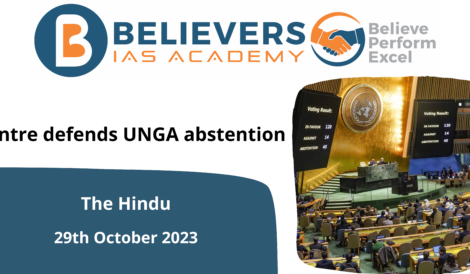On I-Day, Stalin seeks transfer of education back to State List
Context
M.K. Stalin, the chief minister of Tamil Nadu, demanded on Tuesday that education be put back on the State List of the Constitution’s Seventh Schedule. Only this, he claimed, will contribute to the end of centralized exams like NEET. Originally a State topic, education was transferred to the Concurrent List by the Indira Gandhi administration during the Emergency.
When was Education moved from the state List to the Concurrent List?
- Initially included in the State List, education was moved to the Concurrent List by the government of Indira Gandhi during the Emergency. The autonomy of the states in terms of education was weakened by this transfer.
What was the 42nd Amendment and what were its key features?
An important constitutional change in India occurred with the 42nd Amendment Act of 1976. It was passed during the emergency period and made significant amendments to the Indian Constitution. The 42nd Amendment Act has resulted in several significant modifications, including:
- Preamble Modification: To reflect the essence of the Indian Republic, the words “Socialist” and “Secular” were added to the Constitution’s Preamble.
- fundamental duties: All citizens are required to uphold are listed in a new section of the Constitution called Part IV-A. These obligations attempted to instil in citizens a sense of accountability and patriotism.
- Fundamental Rights Modifications: The Constitution’s incorporated Fundamental Rights were modified by the amendment. It was declared that no statute enacting the Directive Principles of State Policy, which are not subject to legal challenge, could be declared unconstitutional on the basis that it infringes upon or restricts Fundamental Rights.
- Right to Property: According to Article 19(1)(f), the property right was once a Fundamental Right but has since been transformed into a legal right. The property right might now be restricted by the government through legislation without having to pay compensation.
- Review of Constitutional Validity: With the introduction of Article 368(5), no constitutional amendment could be challenged in court because it went against the “basic structure” of the Constitution.
- Extension of Emergency Provisions: The 1975 emergency declaration’s six-month extension was made by the modification.
What were the Relevant changes bought in the education sector through the 42nd amendment act?
- List II (State List), Entry 25 of the Seventh Schedule Education, including primary education, excluding universities, subject to the rules of Entries 63, 65, and 66 of List I; vocational and technical training of labour were the topics covered in Entry 25 of List II before the change. It was changed to read: “Education, including primary education and physical culture.”
- List III’s (Concurrent List) Entry 11 reads as follows: Following the terms of Entries 63, 64, 65, and 66 of List I, the amendment added a new Entry 11 to List III, which stated: “Education, including technical education, medical education, and universities; vocational and technical training of labour.”
What are the advantages of Education being on the Concurrent List?
- Uniformity and Standardization: By including education on the Concurrent List, states can create uniform standards and regulations. This may contribute to some degree of national uniformity in terms of educational quality, curriculum, and standards.
- Sharing of Resources and Expertise: For the advancement of education, the federal government may offer funds, resources, and funding assistance to the states. This can help close the educational divide between different regions, which can be especially helpful for states with few resources.
- Coordinated Actions: The inclusion of education on the Concurrent List makes it easier for the federal and state governments to work together. The establishment of a comprehensive and all-encompassing educational policy might result from collaborative efforts.
- Access to Central activities: States may make use of centrally-sponsored plans, initiatives, and education-related activities. These initiatives can provide extra funds and knowledge to raise state education standards.
- Mobility of Students and Professionals: When educational policies are more uniformly applied across the nation, students and professionals can move between states more readily without encountering wildly divergent curricula and requirements.
- Specialization and Expertise: To promote higher education and research in particular disciplines that are beneficial to the entire country, the central government can establish specialized institutions and universities of national importance.
- National issues: Issues at the national level can be effectively controlled by national regulations, such as standardizing competitive tests or addressing problems that go over state lines.
- Alignment with Global Standards: Having specific educational laws and regulations at the national level can aid in bringing Indian education into compliance with best practices and international norms.
What is the latest demand by the Tamil Nadu Government?
- Call for Education to be Transferred to State List: M.K. Stalin, the chief minister of Tamil Nadu, underlined the necessity for education to return to the State List of the Constitution’s Seventh Schedule. This action might potentially lead to the elimination of centralized tests like the NEET (National Eligibility cum Entrance Test), giving the state greater authority over educational policies and decisions.




